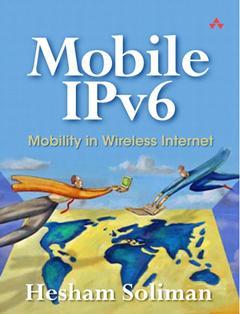Mobile IPv6 : Mobility in a wireless Internet
Langue : Anglais
Auteur : SOLIMAN Hesham

This book focuses on the current Mobile IPv6 standard, which was finalized in 2003 by the Internet Engineering Task Force (IETF). MIPv6 allows a mobile node to transparently maintain connections while moving from one subnet to another. Part I provides the necessary background on IPv6 and the Internet. Part II provides a detailed analysis of the Mobile IPv6 protocol, starting with an overview of the protocol's operation and then moves on to describe the issues involved in securing Mobile IPv6. Part III examines performance and optimization topics related to Mobile IPv6. Part IV is focused on deployment issues for IPv6 and Mobile IPv6. The author presents some of the most important mechanisms designed to allow IPv6 to be deployed in an IPv4 Internet. Then the author uses 3GPP networks as an example for a third generation cellular network. The topic of IPv6 mobility will only gain momentum as the wireless industry continues to grow, supporting over 1 billion devices with unique IP addresses.
Foreword. Preface. Acknowledgements. I. INTRODUCTION.
1. Introduction.
The Internet Protocol Suite.
Networking with the Internet Protocol Suite.
IP Addresses.
The Domain Name System.
Host-to-Host Communication.
Encapsulation.
Demultiplexing.
Routing in the Internet.
Client-Server Versus Peer-to-Peer Communication.
The Need for IPv6.
What Is IP Mobility?
How Important Is Mobility?
Where Do I Need Mobility Management: Layer 2, Layer 3, or Upper Layers?
Mobile IPv6: Main Requirements.
Summary.
2. An IPv6 Primer.
The IPv6 Protocol.
Why Doesn't the IPv6 Header Contain a Checksum Field?
Do We Need a Larger Payload Length Field?
The Flow Label.
IPv6 Extension Headers.
The Hop-by-Hop Options Header.
The Routing Header.
The Fragmentation Header.
IP Layer Security.
The Destination Options Header.
Ordering of the Extension Headers.
ICMPv6.
ICMPv6 Error Messages.
ICMPv6 Informational Messages.
Tunneling.
What Happens to other Fields in the Tunnel Header?
How Many Times Can an IPv6 Packet Be Tunneled?
IPv6 Addresses.
Textual Representation of IPv6 Addresses.
Unicast Addresses.
Multicast Addresses.
Anycast Addresses.
The Unspecified Address.
IPv6 Addresses Containing IPv4 Addresses.
Neighbor Discovery.
Why Does a Node Need to Discover a Neighbor?
Stateless Address Autoconfiguration.
Ingress Filtering.
A Communication Example.
Summary. II. MOBILE IPv6.
3. Mobile IPv6.
Mobile IPv6 Terminology.
Overview of Mobile IPv6.
Binding Updates and Acknowledgments.
Refreshing Bindings.
Why Reverse Tunneling?
Movement Detection.
Returning Home.
Source Address Selection in Mobile Nodes.
Dynamic Home Agent Discovery.
Challenges Associated with Plug and Play for Mobile Nodes.
Can a Mobile Node Have More than One Home Agent?
Virtual Home Links.
Route Optimization.
Sending Route Optimized Packets to Correspondent Nodes.
Receiving Route Optimized Packets from Correspondent Nodes.
Acknowledging Binding Updates Sent to Correspondent Nodes.
What if the Correspondent Node Failed?
Why Not IP in IP Tunneling for Route Optimization?
What if the Mobile Node Failed?
Site-Local Addresses and Mobile IPv6.
A Communication Example.
Summary.
4. Introduction to Security.
What Is Security and Why Is It Needed?
Authentication.
Authorization.
Confidentiality, Integrity Checks, Nonrepudiation, and Replay Attacks.
Cryptography.
Encryption Algorithms and Keys.
Secret Key Encryption.
Public Key Cryptography.
Hash Functions, Message Digests, and Message Authentication Codes.
Nonces and Cookies.
Establishing a Security Association.
Cryptographically Generated Addresses.
Firewalls and Application Level Gateways.
Summary.
5. Securing Mobile IPv6 Signaling.
Why Do We Need to Secure Mobile IPv6?
Using Binding Updates to Launch Attacks.
Attacks Using the Routing Header and Home Address Option.
MITM Attacks on MPS/MPA.
Requirements for Mobile IPv6 Security.
Securing Communication Between Mobile and Correspondent Nodes.

IPv6 Deployment and Management 85,75 €
Securing Messages to the Home Agent.
Date de parution : 04-2004
Ouvrage de 338 p.
18x23 cm
Thèmes de Mobile IPv6 : Mobility in a wireless Internet :
© 2024 LAVOISIER S.A.S.
Ces ouvrages sont susceptibles de vous intéresser

IPv6 Deployment and Management 85,75 €


